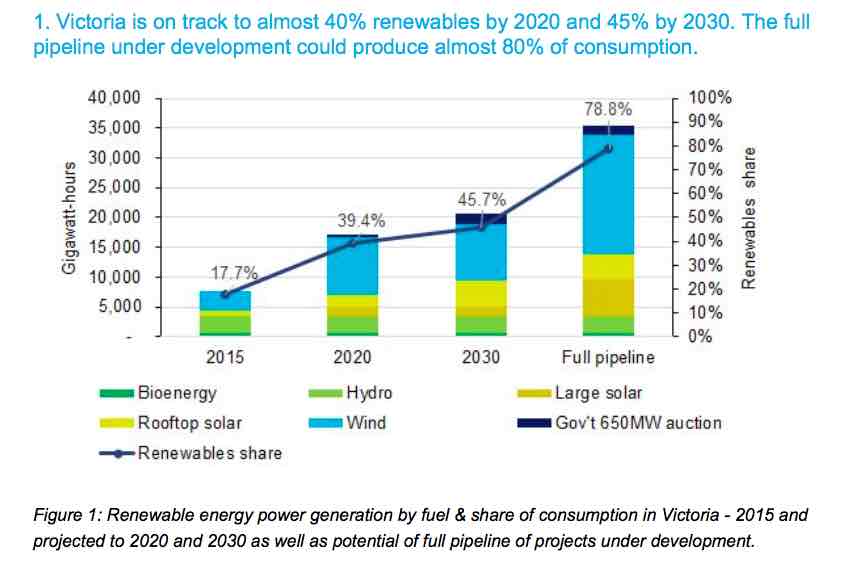 The state of Victoria is likely to meet its 40 per cent renewable energy goal five years early – in 2020 rather than the targeted 2025 – according to the latest analysis from Green Energy Markets.
The state of Victoria is likely to meet its 40 per cent renewable energy goal five years early – in 2020 rather than the targeted 2025 – according to the latest analysis from Green Energy Markets.
The latest Renewable Index Report from GEM says Australia sourced 20.2 per cent of its electricity from renewables in the month of June, and is on target for 33 per cent renewables by 2030, including rooftop solar – as it forecast last month.
This report looks at the individual states in detail. And apart from the faster-than-expected deployment in Victoria, it also confirms that South Australia is heading to 70 per cent renewables by 2020, and 85 per cent by 2030.
Victoria has a 25 per cent target by 2020 and a 40 per cent target by 2025. Both will be easily met, according to this data. And just calculating rooftop solar additions alone could go to 45 per cent by 2030 – any further large scale generation of course would increase that.
 Queensland has awoken from its slumber and its share of renewables will likely jump from 7.4 per cent in 2015 to 25 per cent by 2020, half way to its 2030 target of 50 per cent renewables.
Queensland has awoken from its slumber and its share of renewables will likely jump from 7.4 per cent in 2015 to 25 per cent by 2020, half way to its 2030 target of 50 per cent renewables.
New South Wales, on the other hand, which has no state target or ambition, is likely to trail other states and source less than 20 per cent of its electricity from renewables in 2020 – despite the immense resources of Snowy Hydro, and may only scrape to 26 per cent by 2030.
The report also notes that two new wind farms in Tasmania that are under construction would mean the island state could meet its needs entirely with renewable energy, but it could generate 20 per cent more renewable energy than it consumes if its development projects were to proceed to construction.
 “Tasmania and South Australia are moving towards a position where they could generate more renewable energy than they could consume, even with greater energy storage,” the report says.
“Tasmania and South Australia are moving towards a position where they could generate more renewable energy than they could consume, even with greater energy storage,” the report says.
“Their future is as clean power exporters.”
The report was prepared by GEM for campaign group GetUp. Its campaigns director Miriam Lyons said the data highlighted how with strong targets and the right policies, Australia could have a clean and green future.
“The rapid ramp-up in investment in the past three years have shown the kind of growth possible with strong targets and supporting policy and demonstrates we can reach for far greater targets down the track.
“What the REI demonstrates is there’s a clear option here, we kill off renewables growth and pollute the planet with a do nothing NEG, or we develop a policy that sets strong targets and continues the renewables boom and delivers a cleaner and greener Australia.”








